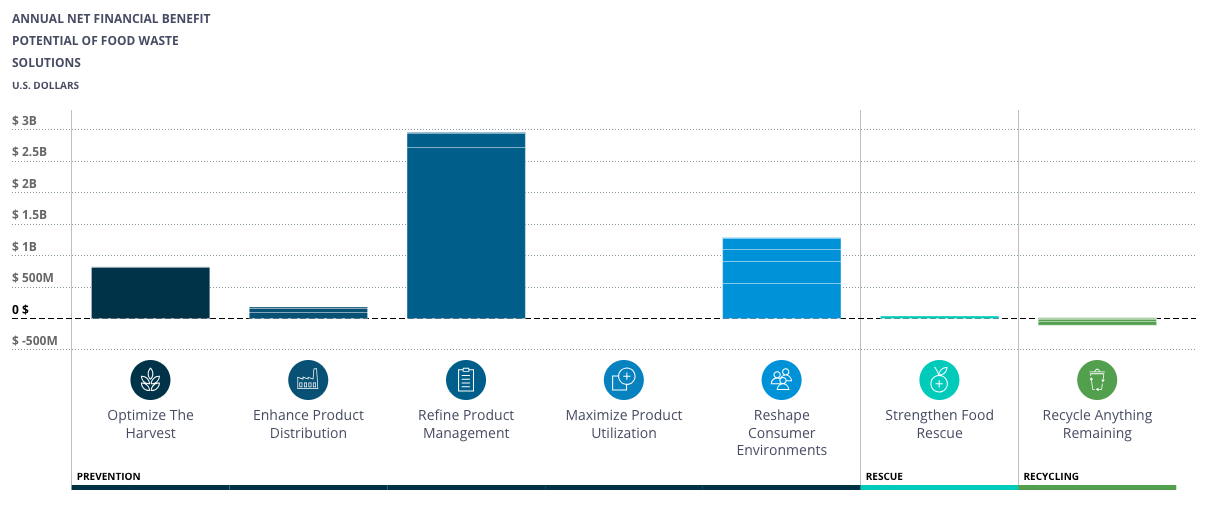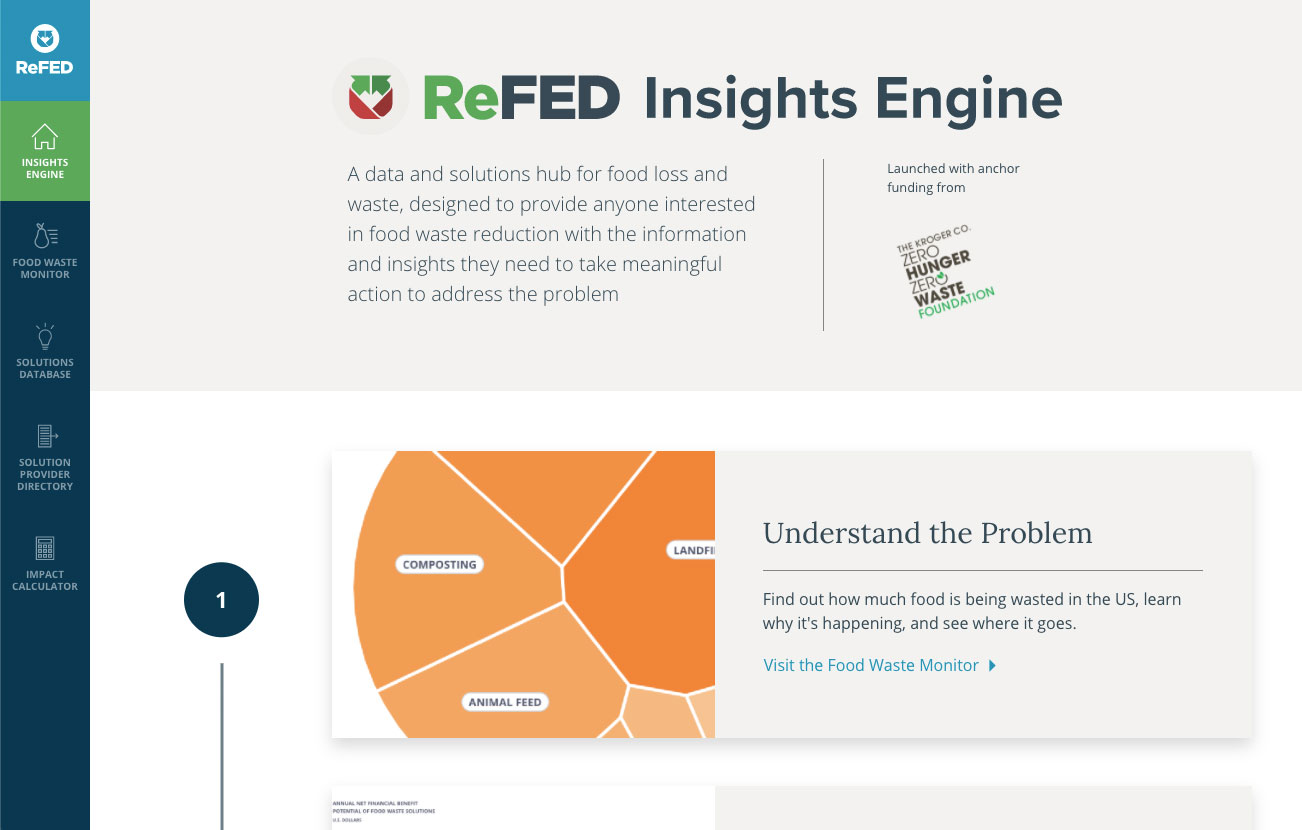Restaurants and Foodservice
Stakeholder Recommendations
Restaurants and Foodservice
Stakeholder RECOMMENDATIONS
Restaurants and Foodservice
Summary
Foodservice includes businesses, institutions, and companies responsible for any meal prepared outside the home, inclusive of restaurants, catering, cafeterias, and the hospitality sector. After being hit especially hard by COVID-19 closures, some Restaurants and Foodservice businesses began to explore cost-cutting measures, which included a greater focus on food waste reduction. But like Retailers, Restaurants and Foodservice businesses serve end customers, and as such face similar demands when it comes to product offerings – even at lower-end outlets, consumers expect that they will get what they want when they want it, forcing businesses to overstock to accommodate fluctuations in demand.
Restaurants and Foodservice businesses generated 13M tons of surplus food in 2022, more than 85% of which went to landfill or was incinerated as waste. Less than 1% of this surplus was donated – mainly because it’s more difficult to transport, store, and distribute food that is already prepared. More than 45% of the total surplus was generated by full-service restaurants, and nearly 70% of the total surplus came from plate waste, or customers not eating what they have taken or been served.
Foodservice is a challenging sector because of the diversity of models; restaurants, cafeterias, buffets, hotels, and other establishments all serve food to customers in similar but unique ways. However, behind the challenge lies a huge opportunity to not only reduce waste in their own operations, but also to make it harder for consumers to waste food – through education and through changing the environment in which food is consumed.
14.6%
Total Surplus Food in 2022 by Restaurants and Foodservice
13M Tons
Causes
Plate Waste - 9.02M Tons (70.3%)
Catering Overproduction - 1.23M Tons (9.6%)
Overproduction - 1.63M Tons (12.7%)
Destinations
Landfill - 10.5M Tons (80.6%)
Composting - 1.17M Tons (9%)
Incineration - 1.2M Tons (9.3%)
Explore solutions that can help Restaurants and Foodservice businesses reduce food waste.
Solutions for this sector can impact food waste generated by other sectors as well, not just waste from Restaurants and Foodservice businesses. ReFED's impact estimates reflect Modeled Solutions only – Unmodeled Solutions and Best Practices can take these amounts even higher.

(Annual Figures)
Top Recommendations
- Offer flexible portion sizes and “à la carte” choices: Discourage plate waste by reducing portion sizes and/or offering customers flexibility in portion sizes, sides, and à la carte options.
- Track waste: Implement waste tracking processes to inform production, menu planning, and inventory management.
- Design low-waste menus: Implement low-waste menu design solutions, including smaller menus, product repurposing, and whole-product utilization.
- Sell end-of-day product: Employ dynamic pricing options for end-of-day sales, such as late happy hours or using markdown alert apps.
- Establish donation relationships: Establish relationships for collection of extra food for donation, either directly with organizations or through matching software solutions.
Optimize The Harvest
Key Opportunities
- Encourage produce distributors to create innovative purchasing models, such as whole-crop purchasing, to ensure full utilization of product grown.
- Establish relationships to accept culls, lower-spec product, and last minute surplus coming off farms, especially with local growers.
Enhance Product Distribution
Key Opportunities
- Encourage distributors to use technology innovations that streamline product movement, such as intelligent routing, temperature monitoring, and early spoilage detection.
- Coordinate across the sector to develop shared economies for idle assets, such as cold storage and transportation, to expand access at lower cost and resource impact.
Refine Product Management
Key Opportunities
- Employ dynamic pricing options for end-of-day sales, such as late happy hours or using markdown alert apps.
- Implement waste tracking processes to inform production, menu planning, and inventory management.
- Alter client-supplier contractual obligations that generate waste and overproduction (e.g., contracts that stipulate that all hot dishes must be available for the full-service period).
- In catering, implement precision event attendance solutions and use aggressive attrition rate calculations to better forecast production needs.
- Improve inventory labeling and storage practices to maximize freshness and shelf life.
Maximize Product Utilization
Key Opportunities
- Implement low-waste menu design solutions, including smaller menus, product repurposing, and whole-product utilization.
- Use left-over ingredients through in-house repurposing practices and consider partnerships that seek large-volume byproducts (e.g., citrus peels, coffee grounds, etc.) as input source for upcycled products.
- Design or implement standard training curriculums and incentive structures to encourage best practices and adherence to solutions like careful trimming, menu design, and food safety.
Reshape Consumer Environments
Key Opportunities
- Discourage plate waste by reducing portion sizes and/or offering customers flexibility in portion sizes, sides, and à la carte options.
- In buffet and cafeteria settings, introduce techniques to encourage people to take smaller portions, such as trayless dining, smaller plates, and pay-by-weight pricing.
- Educate and engage with guests to drive a culture shift towards higher-value placed on food, disincentivizing waste, and improving consumer food management skills, including through signage and menu messaging.
- In K-12 food programs, encourage less waste through offer versus serve, share tables, menu design, and longer lunch periods that occur after recess.
Strengthen Food Rescue
Key Opportunities
- Establish relationships for collection of extra food for donation, either directly with organizations or through matching software solutions.
- Coordinate across the sector to develop shared economies for idle assets, such as cold storage and transportation, to expand access at lower cost and resource impact.
- Scale existing donation programs through enhanced communication between food donors and food banks, and implementing coordination and matching software solutions.
- Implement staff training curriculums regarding donation liability protections and donation best practices, such as storing and packaging procedures.
Recycle Anything Remaining
Key Opportunities
- Collaborate with systems players to demonstrate demand for feedstock, generate consistent inputs, and incentivize investment in recycling infrastructure.
Your Source for Data and Solutions:
ReFED's Insights Engine
The Insights Engine is an online hub for data and insights about food waste built from more than 50 public and proprietary datasets, plus estimates and information from academic studies, industry papers, case studies, and expert interviews; a detailed financial analysis of more than 40 food waste reduction solutions; a directory of organizations ready to partner on food waste reduction initiatives; and more. With more granular data, more extensive analyses, more customized views, and the most up-to-date information, the Insights Engine can provide anyone interested in food waste reduction with the information they need to take meaningful action.


ReFED offers a range of solutions for organizations to advance their own food waste initiatives. Our interactive tools, reports and strategic solutions can help your team get started.
